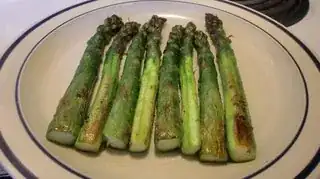I had always heard that pencil thin asparagus is the best, and that has always been what I look for. But now I've heard from a few (what I would consider reliable) sources that skinny isn't better when choosing asparagus. My local grocery tends to get really fat (stems easily an inch in diameter) asparagus that otherwise looks great (nice color, tight tips, no wrinkling). I've always avoided this asparagus even though I love roasted fresh asparagus, because I've expected it to be woody. Is that the case?
I've never peeled asparagus, I've just snapped off the ends at the "break" point. If the consensus is that this fat asparagus is worth trying, should I peel it before roasting?


